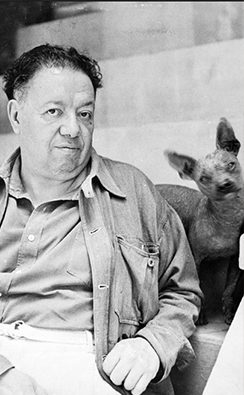Biografía - Diego Rivera 1886-1957
Considered the maximum representative of the Mexican Mural School, Diego Rivera made a monumental work, as much in amount as in volume. Their shining personality, their taste by the controversy, in addition to their talent as painter, made him a personage recognized in the cultural and political panorama of Mexico.
Diego Rivera was born in Guanajuato, in 1886. When he was very young, he traveled with his family to the city of Mexico. He precociously entered the National School of Fine Arts (old Academy of San Carlos) where obtained a solid formation like sketcher and painter. He was disciple of Jose Maria Velazco. The first exposed works of Rivera in the dawn of this century are deeply marked by the lessons of Velazco. In 1907, Rivera managed to travel to Europe thanks to the support of the governor of Veracruz, Don Teodoro Dehesa. In Madrid he frequented a painting academy during two years and he was interested in the painting of El Greco, that he discovered in Toledo.
In 1909, Rivera begun a trip by Europe that took him to Paris, Gante and London. He met Russian painter Angelina Beloff, who would become his first wife. After a brief trip to Mexico, in 1910, Rivera settled in Paris with Angelina.
As of that moment, Rivera was influenced by the vanguard movements that he discovered in Europe. In Montparnasse, where also Picasso, Braque and Modigliani lived, as well as several of the members of the Italian futurist movement, Rivera investigated the creative possibilities of the cube-futurism. Refugee in Spain during World War I, he presented the cubism to the Spanish public. In1915, he returned to his department in Paris and he continued practicing the cubism. In 1917, after a controversy with some French artists, he left that tendency to return to a classic form.
A trip to Italy, made in 1920-1921, marks its passage to the mural: when discovering Italians of quatrocento, Rivera conceives the possibility of painting monumental works. This project agrees with some of the ideas of the philosopher Jose Vasconcelos, whom invites him to return to Mexico in 1921.
In 1922, after a brief trip by the Mexican Republic, Rivera initiates his first mural in the amphitheatre of the National Preparatory School, in the city of Mexico. This work reveals the great influence of the Italian painting. Nevertheless, when initiating his work, two years later, in the walls of the Secretariat of Public Education, Rivera has been freed and manages to conform an own mural painting style at fresh air, in which different influences can be detected: the constructivism of the cubism; the amplitude of the italians of the 1400; the verticality of the compositions taken from El Greco and the colors freely interpreted of the Mexican popular arts, in addition to others.
Between 1922 and 1929, Rivera makes some of his most important creations in Mexico: the fresh airs of the Secretariat of Public Education, those of the School of Chapingo and those of the stairs of the National Palace. Its painting production is relatively modest in that period, although it does not happen the same with the graph: he makes engravings, he illustrates books and posters.
Member of the Union of Painters, created by David Alfaro Siqueiros in1922, movement between 1922 and1924, founder of the Mexican Communist Party, Rivera spend most of his time in the political activities. In1929, shortly after a trip to the Soviet Union, Rivera breaks with the communist party. At the same time, the changes of government in Mexico interrupt their works in the National Palace. He travels to the United States with his third wife, Frida Kahlo. There he dictates conferences in Los Angeles and he makes a mural in the School of Fine Arts. Shortly after, contracted by Henry Ford, he prepares the murals of the Detroit Art Institute, perhaps its greater mural work, in which he raises values of the technical civilization of the XXth century. When finalizing that work, Rivera is in New York to paint a great fresh air in the Rockefeller Center, then in construction. The inclusion in the mural of a picture of Lenin interrupts the work. The scandal spreads, but Rivera does not yield. That mural was destroyed (although Rivera painted it again in Mexico, in the third floor of the Palace of Fine Arts) in 1935. Before leaving New York, Rivera painted a series of panels in a school for trotskyst workers.
Back in Mexico, Rivera accomplished new murals: he completes the stairs of the National Palace and makes decorations in the Secretariat of Health, among other works. It returns more and more, nevertheless, to the painting. He initiates one long series of pictures of figures of the Mexican society, and develops in another format diverse aspects of his murals. Its political participation is not limited to the declarations in the press: militant of IV the International (trotskyst), he invites Leon Trotsky to his own house. He writes articles and he dictates conferences on burning subjects of the moment. In the apogee of their fame, his words are listened by the politicians.
He initiates the construction of his own museum, the pyramid of the Anahuacalli, where he conserves the per-Hispanic pieces that he have collected. He paints the murals of the Lerma River, the Theater of the Insurgents and the University Stadium. The death of Frida Kahlo, in1954, leaves him helpless. Ill, he ravels to Moscow with the intention of find a cure. He married again Emma Hurtado, he lives his last years between his house on San Angel Inn and Acapulco. He dies in 1957.
 Diego Rivera
Diego Rivera